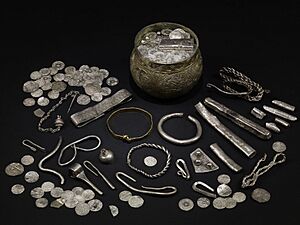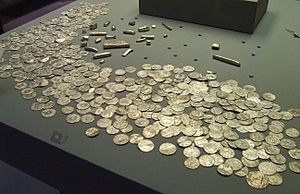Vale of York Hoard facts for kids
Quick facts for kids Vale of York Viking Hoard |
|
|---|---|
 |
|
| Created | 927–928 (deposited), 10th century (mid) |
| Period/culture | Viking, Carolingian |
| Place | North Yorkshire (Vale of York Viking Hoard) |
| Present location | Medieval Gallery, Yorkshire Museum, York |
| Identification | 2007T2 |
The Vale of York Hoard is a huge collection of Viking treasures. It's also known as the Harrogate Hoard. This amazing find includes 617 silver coins and 65 other valuable items. It was discovered in 2007 near Harrogate, a town in North Yorkshire, England. This hoard was the biggest Viking treasure found in Britain in over 150 years! Only the Staffordshire Hoard, found in 2009, is larger.
Contents
How the Hoard Was Found
On January 6, 2007, David Whelan and his son Andrew found the Harrogate Hoard. They were using metal detectors as a hobby. They found the treasure in an empty field that had not yet been plowed.
The hoard was buried about 30 centimeters (about 1 foot) deep. First, they found parts of a lead chest. Then, a silver bowl fell from the side of their dig. Inside the bowl, they could see coins and pieces of silver.
The Whelans quickly reported their find to the Portable Antiquities Scheme. They were praised for keeping the treasure together and not taking all the objects out of the bowl. They also marked the exact spot where they found it. This was very helpful because heavy rains washed away other clues just a few days later.
The hoard was then taken to the British Museum. Experts there carefully removed each item to protect them and learn more about how they were found. The discovery was announced on July 19, 2007. The British Museum said it was the most important find of its kind in Britain for over 150 years. They also called it a "globally important" discovery.
A court hearing in Harrogate officially declared the hoard a "Treasure." This means museums can buy it, and the money is shared between the finders and the landowner.
What Was in the Hoard?
The hoard contains 617 silver coins and 65 other items. These include ornaments, silver bars (called ingots), and other precious metals. All these items were hidden inside a beautiful silver cup decorated with gold. This cup might have been a church vessel from Northern France. It was probably taken as loot or given as a gift.
The cup is decorated with vines, leaves, and six running animals. These animals include two lions and four other beasts. This cup is very similar to another one called the Halton Moor cup. Both cups were likely made in the same workshop around the mid-9th century. The entire collection was buried inside a lead chest.
Other interesting items found include a rare gold arm ring, possibly from Ireland. There was also "hacksilver," which are cut pieces of metal used as money. The coins show symbols from different religions: Islam, Christianity, and old Norse paganism. Some coins even mixed Christian and pagan symbols. This shows how some Vikings were starting to become Christian.
The hoard was protected by lead sheeting. The coins date from the late 9th and early 10th centuries. This helps experts figure out when the hoard was buried. One idea is that a wealthy Viking leader buried it around 927. This was a time of trouble after the Anglo-Saxon king Athelstan took over the Viking kingdom of Northumbria. Another idea is that it was buried during a later period of Viking rule, which ended in 954.
The items in the hoard came from many different places. These include faraway lands like Uzbekistan, North Africa, Afghanistan, Russia, Ireland, Scandinavia, and other parts of Europe. This shows how far Vikings traveled and traded.
Where to See the Hoard
The Vale of York Hoard was valued at £1,082,000 (over one million pounds). The York Museums Trust and the British Museum bought it together.
Since September 2009, parts of the hoard have been on display at the Yorkshire Museum in York. It was moved to the British Museum for more work and then returned to the Yorkshire Museum when it reopened in August 2010.
In 2012, the hoard was part of a special exhibition in Harrogate. After that, it traveled to Copenhagen, Berlin, and London. It was also a main part of the British Museum's big Vikings exhibition in 2014.
The hoard was put back on display at the Yorkshire Museum in 2015. Since 2017, it has been part of a traveling exhibition called 'Viking: Rediscover the Legend'. It is shown alongside other famous hoards like the Bedale Hoard and the Cuerdale Hoard. This tour has visited places like Southport, Aberdeen, Norwich, and Nottingham.
Images for kids
See also
 In Spanish: Tesoro del valle de York para niños
In Spanish: Tesoro del valle de York para niños




